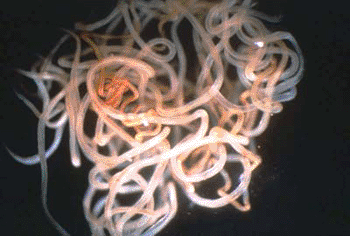Urine Test Diagnoses River Blindness Infection
By LabMedica International staff writers
Posted on 11 Mar 2013
A telltale molecular marker for onchocerciasis or river blindness has been discovered that may lead to a potential field test. Posted on 11 Mar 2013
The newly discovered biomarker is secreted by Onchocerca volvulus worms during an active infection and as it is detectable in patients' urine, and it could form the basis of a portable, field-ready test with significant advantages over current diagnostic methods.

Image: Onchocerca volvulus (adult worms) (Photo courtesy of ICP).
Scientists at The Scripps Research Institute (La Jolla, CA, USA) analyzed onchocerciasis-positive urine samples that were collected in characterized endemic areas in Africa, and their status was confirmed by either positive skin snip (microfilaria-positive) or nodule palpation (nodule-positive). O. volvulus negative urine control samples were also obtained from healthy donors from the USA.
The investigators used liquid chromatography-mass spectroscopy based urine metabolome analysis for the identification of a diagnostic marker of O. volvulus that appears only during an active, microfilariae-producing infection and that could determine both the presence and the severity of disease. They measured the concentrations of hundreds of small-molecule metabolites in the samples and found a unique biomarker, a neurotransmitter derived secretion metabolite from O. volvulus, called N-acetyltyramine-O,β-glucuronide (NATOG).
In urine samples from Africans with active onchocerciasis infections, the scientists found that levels of the biomarker were on average four to six times higher than in samples from Africans with nonactive infections. In a separate test, the team determined that a full course of doxycycline treatment, which sterilizes or kills infecting worms by destroying their symbiotic bacteria, Wolbachia pipientis, also reduced levels of the biomarker to near-normal. The metabolome-mining approach in theory should be applicable to the development of diagnostic tests for other worm diseases.
Daniel Globisch, PhD, the senior author of the study, said, "This biomarker appears to be specific for an active infection, The wide gap between biomarker levels in active and non-active infections suggests that a field test based on the biomarker would be robustly useful." Kim D. Janda, PhD, a professor at Scripps said, " Ultimately for this to be of value in Third World countries we will need to morph this biomarker into something that's inexpensive, simple to use, tolerant of extreme temperatures and portable, basically distilling our finding to a test that can be carted around in a backpack." The study was published on February 25, 2013, in the journal Proceedings of the National Academy of Sciences of the United States of America (PNAS).
Related Links:
The Scripps Research Institute













